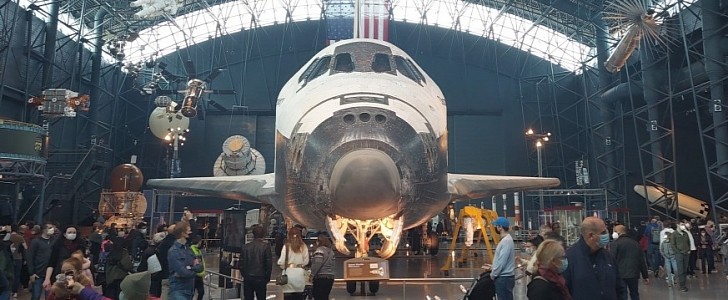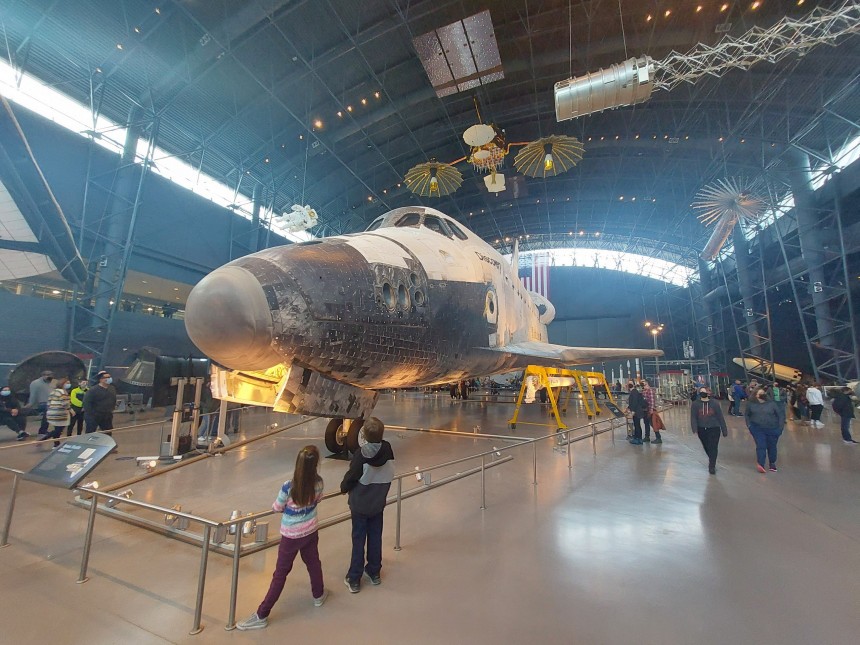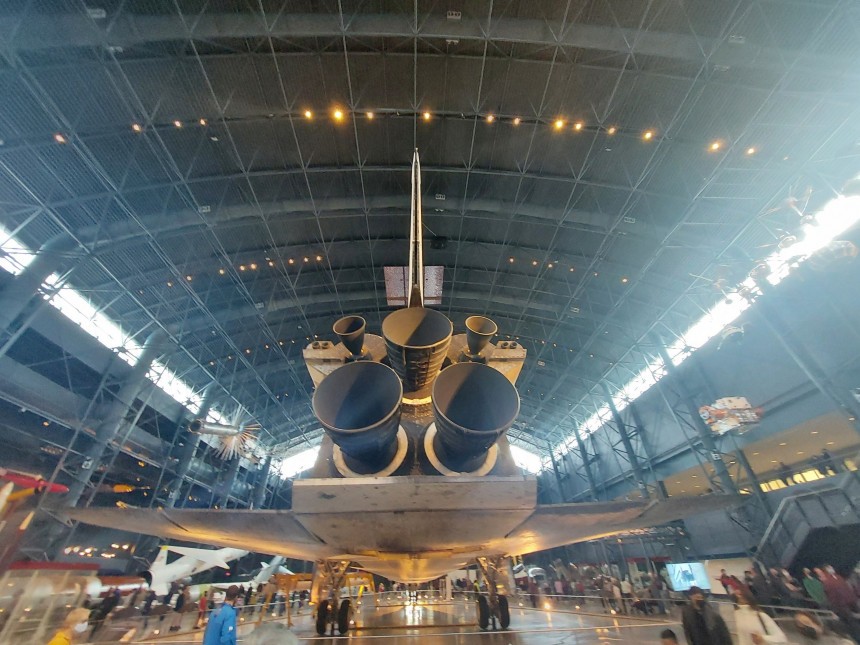Our trip to the Steven F. Udvar-Hazy Center in Chantilly, Virginia, was one of the most exciting trips we've taken for Spotlight USA thus far. But we've saved the best for the last folks.
There's one reason most people are drawn to the Smithsonian's official Air and Space museum annex outside Washington D.C. It's to see a real spacefaring legend of our time, a genuine NASA Space Shuttle.
The Space Shuttle Orbiter Discovery completed 39 spectacular missions to space, totaling 8,783 hours and 238,539,663 kilometers (148,221,675 mi) around the Earth. Those kinds of numbers would have boggled the mind of engineers and scientists when the craft was just an idea and some blueprints. By the time of Discovery's retirement in 2011, such trips were routine, almost mundane, in fact.
Discovery was named for two colonial-era British merchants and warships that were instrumental in the colonization and ultimate founding of the United States in 1602 and 1774, respectively. The former of the two was captained by the famous explorer Henry Hudson.
The contract to construct the third of five Shuttle Orbiters to fly was given to the Rockwell International conglomerate in January 1979. Further accompaniments like the wings came from the Grumman Aerospace Corporation of Bethpage, New York.
Shuttle Discovery's official rollout was celebrated in October 1983. It was up in space for its first flight on STS-41D soon after, deploying three civilian commercial satellites. This would only be the beginning of Discovery's accolades. The Shuttle then deployed the iconic Hubble Space Telescope into low earth orbit on mission STS-31. The telescope is still in operation today. This was followed up with the successful deployment of the Ulysses probe, whose primary mission was to orbit the sun and observe it from every angle possible.
These two accomplishments alone would be the envy of any successful spacecraft. But Shuttle Discovery was just getting started. Discovery carried the elderly former Mercury Program astronaut John Glenn into space for the first time since the historic Friendship 7 mission in 1962. At 77 years of age, the astronaut and former U.S. Senator from Ohio became the oldest person to reach low earth orbit.
Shuttle Discovery housed the Spacelab mobile and reusable laboratory in its internal payload bay several times. The module flown aboard Discovery finds its home in the self-contained space flight exhibit room at the Hazy Center, as it's often shortened to. Most tragically, Shuttle Discovery represented the return to flight status of the Space Shuttle program after the accidents that occurred with the respective Challenger and Columbia Shuttle orbiters nearly 20 years apart from each other.
Shuttle Discovery topped off these feats with resupply trips to the Russian Mir Space Station and the International Space Station, respectively. A chore that became far more difficult with the Shuttle program's retirement in 2011. The Steven F. Udvar-Hazy Center was already home to the Shuttle Enterprise atmospheric trainer at the time of Discovery's retirement. A formal exchange between the two shuttles was made before Enterprise was shipped to New York City to its resting place at the USS Intrepid Air and Space Museum in Mid Town-Manhattan.
Meanwhile, Discovery and Spacelab became the centerpiece of a museum that staff and administration hope one day will total as many as 300 aircraft. Discovery's special Canadarm robotic arm is proudly on display next to the orbiter. The arm was the main medium the Shuttle used to interact with other manmade spacecraft.
The Smithsonian kindly asked NASA not to clean or polish the exterior of the spacecraft after its final re-entry into the atmosphere. The administration wanted to detail just what gargantuan forces are at play in the fire of re-entry. NASA was all too happy to save some taxpayer money and oblige.
If you have any questions, the museum has a remote historian available via a T.V. and Microphone at the exhibit to answer any questions museum-goers may have. We will say this one thing to close. It never gets old seeing people's jaws hit the floor when they see how huge the Shuttle Orbiter is in the flesh. We get a kick out of it every time.
Many, many thanks to the Smithsonian Institution's P.R. team, administration, and staff for allowing us to photograph and showcase what has to be the coolest single item on display at the Steven F. Udvar-Hazy Center. Check back for more real soon right here on autoevolution.
The Space Shuttle Orbiter Discovery completed 39 spectacular missions to space, totaling 8,783 hours and 238,539,663 kilometers (148,221,675 mi) around the Earth. Those kinds of numbers would have boggled the mind of engineers and scientists when the craft was just an idea and some blueprints. By the time of Discovery's retirement in 2011, such trips were routine, almost mundane, in fact.
Discovery was named for two colonial-era British merchants and warships that were instrumental in the colonization and ultimate founding of the United States in 1602 and 1774, respectively. The former of the two was captained by the famous explorer Henry Hudson.
The contract to construct the third of five Shuttle Orbiters to fly was given to the Rockwell International conglomerate in January 1979. Further accompaniments like the wings came from the Grumman Aerospace Corporation of Bethpage, New York.
These two accomplishments alone would be the envy of any successful spacecraft. But Shuttle Discovery was just getting started. Discovery carried the elderly former Mercury Program astronaut John Glenn into space for the first time since the historic Friendship 7 mission in 1962. At 77 years of age, the astronaut and former U.S. Senator from Ohio became the oldest person to reach low earth orbit.
Shuttle Discovery housed the Spacelab mobile and reusable laboratory in its internal payload bay several times. The module flown aboard Discovery finds its home in the self-contained space flight exhibit room at the Hazy Center, as it's often shortened to. Most tragically, Shuttle Discovery represented the return to flight status of the Space Shuttle program after the accidents that occurred with the respective Challenger and Columbia Shuttle orbiters nearly 20 years apart from each other.
Shuttle Discovery topped off these feats with resupply trips to the Russian Mir Space Station and the International Space Station, respectively. A chore that became far more difficult with the Shuttle program's retirement in 2011. The Steven F. Udvar-Hazy Center was already home to the Shuttle Enterprise atmospheric trainer at the time of Discovery's retirement. A formal exchange between the two shuttles was made before Enterprise was shipped to New York City to its resting place at the USS Intrepid Air and Space Museum in Mid Town-Manhattan.
The Smithsonian kindly asked NASA not to clean or polish the exterior of the spacecraft after its final re-entry into the atmosphere. The administration wanted to detail just what gargantuan forces are at play in the fire of re-entry. NASA was all too happy to save some taxpayer money and oblige.
If you have any questions, the museum has a remote historian available via a T.V. and Microphone at the exhibit to answer any questions museum-goers may have. We will say this one thing to close. It never gets old seeing people's jaws hit the floor when they see how huge the Shuttle Orbiter is in the flesh. We get a kick out of it every time.
Many, many thanks to the Smithsonian Institution's P.R. team, administration, and staff for allowing us to photograph and showcase what has to be the coolest single item on display at the Steven F. Udvar-Hazy Center. Check back for more real soon right here on autoevolution.














